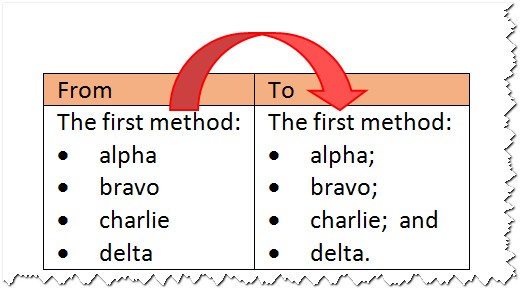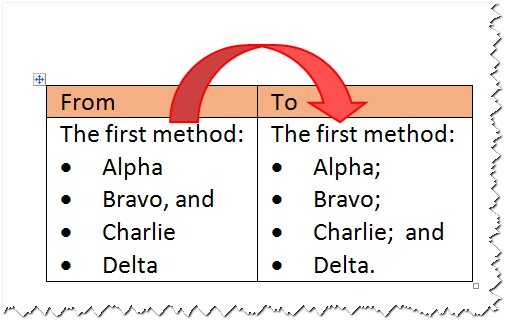This post describes three great tools for managing bulleted lists in Microsoft Word.
They allow you to automatically punctuate them , reorder them , and select them for further processing.
This post complements my earlier article Three Great Tools for Editing Tables that described tools for efficiently entering and numbering the content in Microsoft Word tables.
I use Microsoft Word a great deal in my work as a BA, it is my primary tool for formally communicating text based project deliverables.
I like to make frequent use of bulleted lists. The preceding statement that sets the context for the list removes the need for low value repetition, and allows the reader to focus on the key messages without surrounding clutter.
I often create bulleted lists by recording points as quickly as I can. By concentrating on the ideas, sometimes I don't punctuate the list properly as I go. On other occasions, I need to add entries or move the order of the entries around. It either case, there can be a tedious task of formatting the entries correctly.
Word lacks tools to help me in these situations, so I decided to develop my own using VBA, the development tool that comes with Microsoft Office.
Using these tools makes me much more efficient, and allows me to present consistent formatting with just a few keystrokes. The tools are free to use and modify. They can be downloaded from the link in the signature block at the end of this post.
Automatically Punctuate a Bulleted List
Many of my clients have different standards for punctuating bulleted lists. Some like to present them as fully formed sentences by using a semi-colon at the end of each entry, placing a “; and” at the end of second to last entry, and a “.” at the end of the final line. This is a real pain if you have to add entries or reorder them.
Other clients others like a simple “.” at the end of each entry, and I have encountered a number of other variations that apply in different situations, even for the same client.
To use the tool, place the cursor anywhere inside a bulleted list and select the shortcut key for one of the following supported punctuation styles:

The tool will select the entire list and apply the rule as shown.

You don’t have to select the list, just put the cursor anywhere in the text of a list and the tool does the selection for you.
After the list is selected, it removes all existing punctuation and reapplies the selected style. This means you can change the order of a list and the tool will correct the punctuation with just a key press. In the following example, note how the “, and” has been removed and correctly applied to the later line.

The tool is smart enough to handle bulleted lists inside tables, and bulleted lists in documents with numbered paragraphs.
There is even logic to handle track changes if it is switched on. The will tool temporarily switch off track changes, correct the punctuation, and switch track changes back on. This means that the tool does not create unwanted change alerts.
Microsoft Word has no equivalent tool.
Move Bulleted List Entries Up and Down
Word provides a tool to move paragraphs or bulleted list entries up or down (see Ctrl+Shift +Up/Down). This may not be well known, but works fine if the bulleted list is in standard text.
If you try this key combination inside a table, instead of moving paragraphs, it moves table rows up/down.
I have extended the standard tool so that, as well as its normal functions, you can also move entries in a bulleted list inside a table cell.
All you need to do is place the cursor anywhere in the text of a list entry and press the shortcut key. The entry will then move up/down. Keep hitting the key and the entry keeps moving until it gets to the top or bottom of the list, or the boundary of a table cell.
If you use tables frequently, you will find this is a very handy tool.
I assign the tool to the shortcut keys used by the standard capability so I can use the full capabilities when I need them.
Select a Bulleted List for Further Processing
If the cursor is placed inside the text of a bulleted list entry, the tool will then select the entire list, allowing you to process it further or apply a different style.
This tool uses the basic list select features of the first tool, and can therefore handle lists in table cells, and lists in documents with numbered paragraphs.
Microsoft Word has no equivalent tool.
Summary
I use these tools every day, without them, would find my productivity levels dropping, and my frustration levels rising. A good BA has a bag full of useful tools and I hope you find useful and add them to your toolkit.
About the Author
Martin Coomber is a BA based in Wellington, New Zealand. He is a Certified Business Analyst Professional, tutors IIBA study groups, and mentors other BAs. His Document Productivity website provides document editing tools to the BA community.